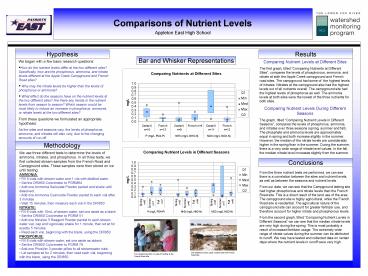Comparisons of Nutrient Levels PowerPoint PPT Presentation
1 / 1
Title: Comparisons of Nutrient Levels
1
Comparisons of Nutrient Levels
Appleton East High School
Hypothesis
Results
Bar and Whisker Representations
- We began with a few basic research questions
- How do the nutrient levels differ at the two
different sites? Specifically, how are the
phosphorus, ammonia, and nitrate levels different
at the Apple Creek Campground and French Road
sites? - Why may the nitrate levels be higher than the
levels of phosphorus or ammonia? - What effect do the seasons have on the nutrient
levels at the two different sites? Are there any
trends in the nutrient levels from season to
season? Which season would be most likely to
induce an increase in phosphorus, ammonia, or
nitrate levels at the two different sites? - From these questions we formulated an appropriate
hypothesis - As the sites and seasons vary, the levels of
phosphorus, ammonia, and nitrates will also vary,
due to the changing amounts of run-off.
Comparing Nutrient Levels at Different Sites The
first graph, titled Comparing Nutrients at
Different Sites, compares the levels of
phosphorous, ammonia, and nitrate at both the
Apple Creek campground and French road sites. The
campground had some of the highest levels of
nitrates. Nitrates at the campground also had the
highest levels out of all nutrients overall. The
campground site had the highest levels of
phosphorus as well. The ammonia levels at both
sites were the lowest of the three nutrients for
both sites. Comparing Nutrient Levels During
Different Seasons The graph, titled Comparing
Nutrient Levels in Different Seasons, compares
the levels of phosphorus, ammonia, and nitrates
over three seasons (spring, summer and fall). The
phosphate and ammonia levels are approximately
equal in spring and both increase slightly in the
summer. However, the median of the nitrate levels
are considerably higher in the spring than in the
summer. During the summer, there is a very wide
range of nitrate level values. In the fall, the
median nitrate level increases slightly from the
summer.
Methodology
- We use three different tests to determine the
levels of ammonia, nitrates, and phosphorus. In
all three tests, we first collected stream
samples from the French Road and Campground
sites. These samples were then stored on ice
until testing. - AMMONIA
- Fill 5 vials with stream water and 1 vile with
distilled water. - Set the DR/850 Colorimeter to PGRM64
- Add one Ammonia Salicylate Powder packet and
shake until dissolved. - Add one Ammonia Cyanurate Powder packet to each
vial after 3 minutes - Wait 15 minutes, then measure each vial in the
DR/850 - NITRATE
- Fill 6 vials with 10mL of stream water set one
aside as a blank - Set the DR/850 Colorimeter to PGRM 51
- Add one NitraVer 5 Reagent Powder packet to each
stream water vial cap and vigorously shake for 1
minute, then let sit for exactly 5 minutes. - Read each vial, beginning with the blank, using
the DR/850. - PHOSPORUS
- Fill 6 vials with stream water set one aside as
ablank. - Set the DR/850 Colorimeter to PGRM 79.
- Add one PhosVer 3 powder pillow to all
streamwater vials. - Let samples sit for 2 minutes, then read each
vial, beginning with the blank, using the DR/850.
Conclusions
From the three nutrient tests we performed, we
can see there is a correlation between the sites
and nutrient levels, as well as between the
seasons and nutrient levels. From our data, we
can see that the Campground testing site had
higher phosphorous and nitrate levels than the
French Road site. This is a direct result of the
land use of the area. The campground site is
highly agricultural, while the French Road site
is residential. The agricultural nature of the
campground site can account for greater
fertilizer use, and therefore account for higher
nitrate and phosphorous levels. From the second
graph, titled Comparing Nutrient Levels in
Different Seasons we can see that the median
nitrate levels are very high during the spring.
This is most probably a result of increased
fertilizer usage. The extremely wide range of
nitrate values during the summer can be
attributed to runoff. We may have tested and
collected data on certain days where the nutrient
levels in runoff were very high.
The detention basin outlet, located near the
French Road site.
Two students perform on-site pH testing at the
French Road site.

